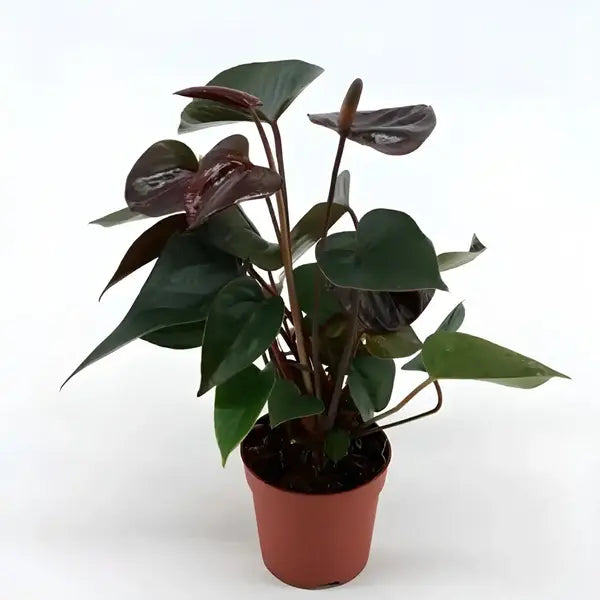
Anthurium Chocolate - Double Shoot
Selling Size : Please Choose | Pot Included | Secure Packing
Anthurium 'Chocolate' is a unique and sought-after variety known for its deep, glossy, chocolate-brown leaves and often rich chocolate-purple spathes (what are commonly mistaken for flowers). Like other anthuriums, it's a tropical plant that thrives in conditions mimicking its native Central and South American rainforest environment.
Here's a comprehensive guide to caring for your Anthurium 'Chocolate':
1. Light:
Bright, Indirect Light is Key: This is crucial for healthy growth and blooming. Place your plant in a spot where it receives plenty of bright, filtered light, such as near an east or west-facing window, or a few feet away from a bright south-facing window.
Avoid Direct Sun: Direct sunlight, especially harsh afternoon sun, can scorch the dark leaves and cause them to turn yellow or brown.
Low Light Issues: Too little light can lead to slower growth, fewer blooms, and muted leaf color. If your plant isn't blooming, it might need more light.
2. Watering:
Allow Soil to Dry Partially: Water when the top 50-75% (or top 2 inches) of the soil is dry to the touch. Anthuriums are susceptible to root rot, so good drainage is essential.
Water Thoroughly: When you water, do so until liquid flows through the drainage hole at the bottom of the pot. Discard any excess water that collects in the saucer.
Avoid Overwatering and Underwatering:
Overwatering: Can lead to yellow leaf tips, mushy stems, and root rot.
Underwatering: Can cause brown leaf tips and drooping/puckering leaves.
Frequency: This will vary depending on your environment, pot size, and time of year. In warmer months, you might water more frequently (e.g., once or twice a week). In winter, reduce watering.
3. Humidity:
High Humidity is Preferred: Anthuriums are tropical plants and thrive in high humidity (ideally 50% or higher).
Increase Humidity:
Mist regularly: Mist the leaves every 2-3 days, especially during spring and summer, and in dry indoor environments.
Pebble tray: Place the pot on a tray filled with pebbles and water (ensure the pot isn't sitting directly in the water).
Humidifier: Use a humidifier in the room, especially during dry winter months.
Group plants: Grouping plants together can create a mini-climate with higher humidity.
4. Temperature:
Warm and Consistent: Anthurium 'Chocolate' prefers average to warm temperatures between 18∘C and 29∘C (65∘F and 85∘F).
Avoid Extremes: Protect your plant from temperatures below 15∘C (60∘F), as well as sudden drafts from open windows, heating, or air conditioning vents.
5. Soil:
Well-Draining and Aerated: Anthuriums, especially 'Chocolate' with its dark leaves, benefit from a coarse, well-draining, and highly organic potting mix that mimics their epiphytic (tree-dwelling) nature.
Recommended Mix: A good mix can include:
40% peat moss or coco coir (for moisture retention and acidity)
30% perlite or pumice (for excellent drainage)
20% orchid bark or chunky pine bark (for aeration and mimicking natural habitat)
10% activated charcoal (to remove toxins and prevent mold)
Slightly Acidic pH: They prefer slightly acidic soil (pH 5.5-6.5).
6. Fertilizer:
During Growing Season: Fertilize every month or two during the spring and summer (the active growing season) with a balanced, water-soluble fertilizer, or one formulated for anthuriums, high in phosphorus (the middle number in NPK).
Dilute: Dilute the fertilizer to half or quarter strength to avoid burning the roots.
Apply to Damp Soil: Always apply fertilizer to damp soil, never dry.
Reduce in Winter: Do not fertilize during the fall and winter when the plant's growth slows.
7. Pruning:
Remove Spent Flowers and Yellowing Leaves: Regularly snip off any drooping or faded flower stalks (spathes) and yellowing or dead leaves at their base. This encourages the plant to put energy into new growth and blooms.
Shape as Needed: You can prune to maintain the plant's shape, but always leave at least 3-4 healthy leaves.
8. Repotting:
When Rootbound: Anthuriums tolerate being slightly rootbound but bloom best when repotted before they become too crowded.
Frequency: Repot typically every 1-2 years, or when you see roots growing out of the drainage holes or the plant becomes top-heavy.
Pot Size: Choose a pot that is only slightly larger than the previous one (e.g., 1-2 inches wider).
9. Pests and Diseases:
Common Pests: Watch out for common houseplant pests like aphids, mealybugs, spider mites, scale, and whiteflies.
Treatment: Wipe leaves with a damp cloth, or use neem oil or insecticidal soap if an infestation occurs.
Root Rot: The most common issue is root rot, usually caused by overwatering or poor drainage. Ensure proper watering and a well-draining soil mix.
Leaf Spot: Can occur with high humidity and poor ventilation. Ensure good air circulation.
Important Considerations:
Toxicity: Anthuriums are considered toxic to pets and humans if ingested. Keep them out of reach of children and animals.
Acclimation: When you first bring an Anthurium 'Chocolate' home, it might need some time to acclimate to its new environment. Provide consistent care during this period.
By following these care tips, your Anthurium 'Chocolate' should thrive and reward you with its stunning foliage and unique blooms.

